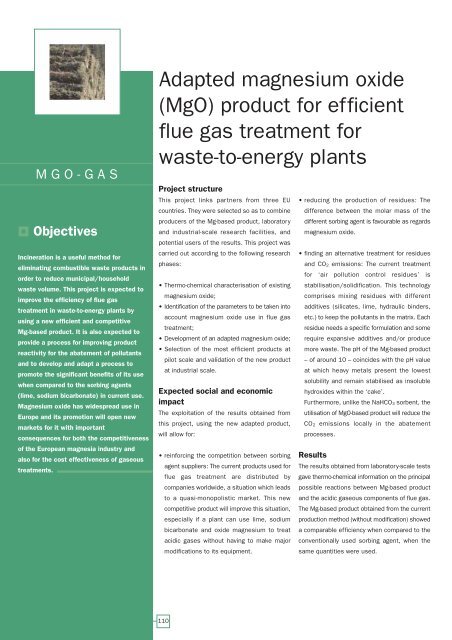European Bio-Energy Projects
European Bio-Energy Projects
European Bio-Energy Projects
You also want an ePaper? Increase the reach of your titles
YUMPU automatically turns print PDFs into web optimized ePapers that Google loves.
MGO-GAS<br />
Objectives<br />
Incineration is a useful method for<br />
eliminating combustible waste products in<br />
order to reduce municipal/household<br />
waste volume. This project is expected to<br />
improve the efficiency of flue gas<br />
treatment in waste-to-energy plants by<br />
using a new efficient and competitive<br />
Mg-based product. It is also expected to<br />
provide a process for improving product<br />
reactivity for the abatement of pollutants<br />
and to develop and adapt a process to<br />
promote the significant benefits of its use<br />
when compared to the sorbing agents<br />
(lime, sodium bicarbonate) in current use.<br />
Magnesium oxide has widespread use in<br />
Europe and its promotion will open new<br />
markets for it with important<br />
consequences for both the competitiveness<br />
of the <strong>European</strong> magnesia industry and<br />
also for the cost effectiveness of gaseous<br />
treatments.<br />
Adapted magnesium oxide<br />
(MgO) product for efficient<br />
flue gas treatment for<br />
waste-to-energy plants<br />
Project structure<br />
This project links partners from three EU<br />
countries. They were selected so as to combine<br />
producers of the Mg-based product, laboratory<br />
and industrial-scale research facilities, and<br />
potential users of the results. This project was<br />
carried out according to the following research<br />
phases:<br />
• Thermo-chemical characterisation of existing<br />
magnesium oxide;<br />
• Identification of the parameters to be taken into<br />
account magnesium oxide use in flue gas<br />
treatment;<br />
• Development of an adapted magnesium oxide;<br />
• Selection of the most efficient products at<br />
pilot scale and validation of the new product<br />
at industrial scale.<br />
Expected social and economic<br />
impact<br />
The exploitation of the results obtained from<br />
this project, using the new adapted product,<br />
will allow for:<br />
• reinforcing the competition between sorbing<br />
agent suppliers: The current products used for<br />
flue gas treatment are distributed by<br />
companies worldwide, a situation which leads<br />
to a quasi-monopolistic market. This new<br />
competitive product will improve this situation,<br />
especially if a plant can use lime, sodium<br />
bicarbonate and oxide magnesium to treat<br />
acidic gases without having to make major<br />
modifications to its equipment.<br />
110<br />
• reducing the production of residues: The<br />
difference between the molar mass of the<br />
different sorbing agent is favourable as regards<br />
magnesium oxide.<br />
• finding an alternative treatment for residues<br />
and CO2 emissions: The current treatment<br />
for ‘air pollution control residues’ is<br />
stabilisation/solidification. This technology<br />
comprises mixing residues with different<br />
additives (silicates, lime, hydraulic binders,<br />
etc.) to keep the pollutants in the matrix. Each<br />
residue needs a specific formulation and some<br />
require expansive additives and/or produce<br />
more waste. The pH of the Mg-based product<br />
– of around 10 – coincides with the pH value<br />
at which heavy metals present the lowest<br />
solubility and remain stabilised as insoluble<br />
hydroxides within the ‘cake’.<br />
Furthermore, unlike the NaHCO3 sorbent, the<br />
utilisation of MgO-based product will reduce the<br />
CO2 emissions locally in the abatement<br />
processes.<br />
Results<br />
The results obtained from laboratory-scale tests<br />
gave thermo-chemical information on the principal<br />
possible reactions between Mg-based product<br />
and the acidic gaseous components of flue gas.<br />
The Mg-based product obtained from the current<br />
production method (without modification) showed<br />
a comparable efficiency when compared to the<br />
conventionally used sorbing agent, when the<br />
same quantities were used.

















